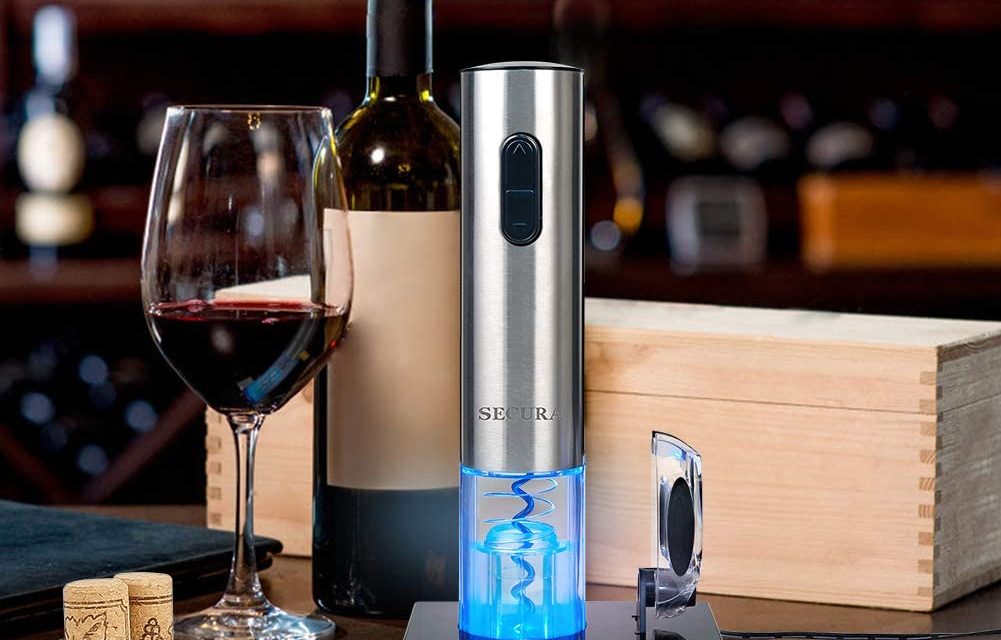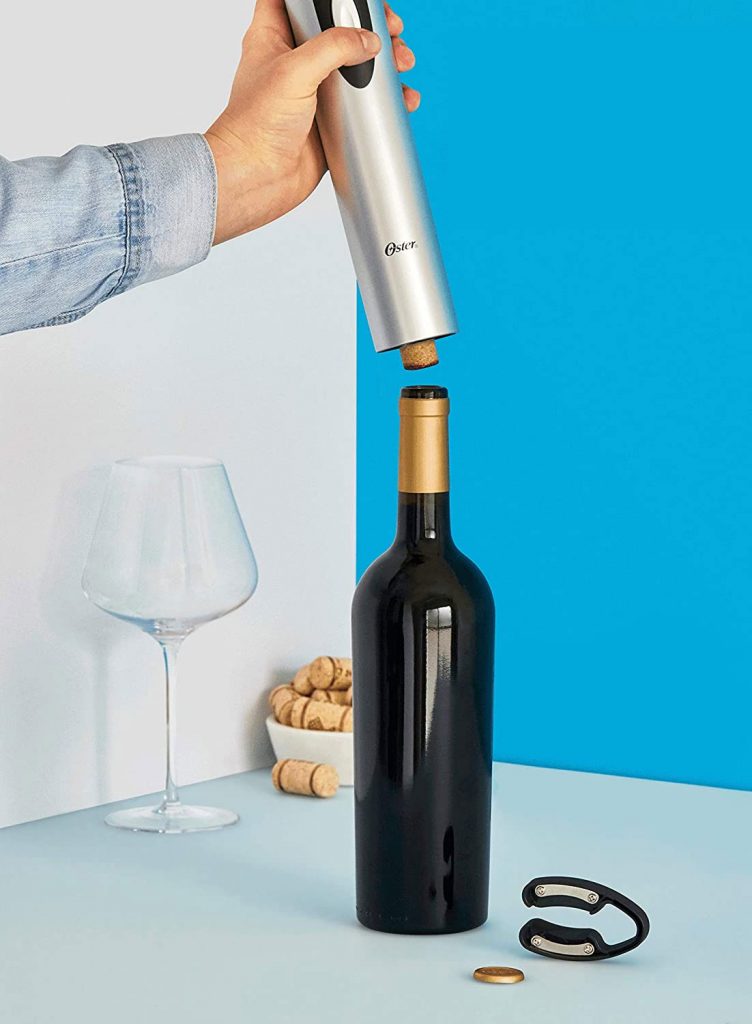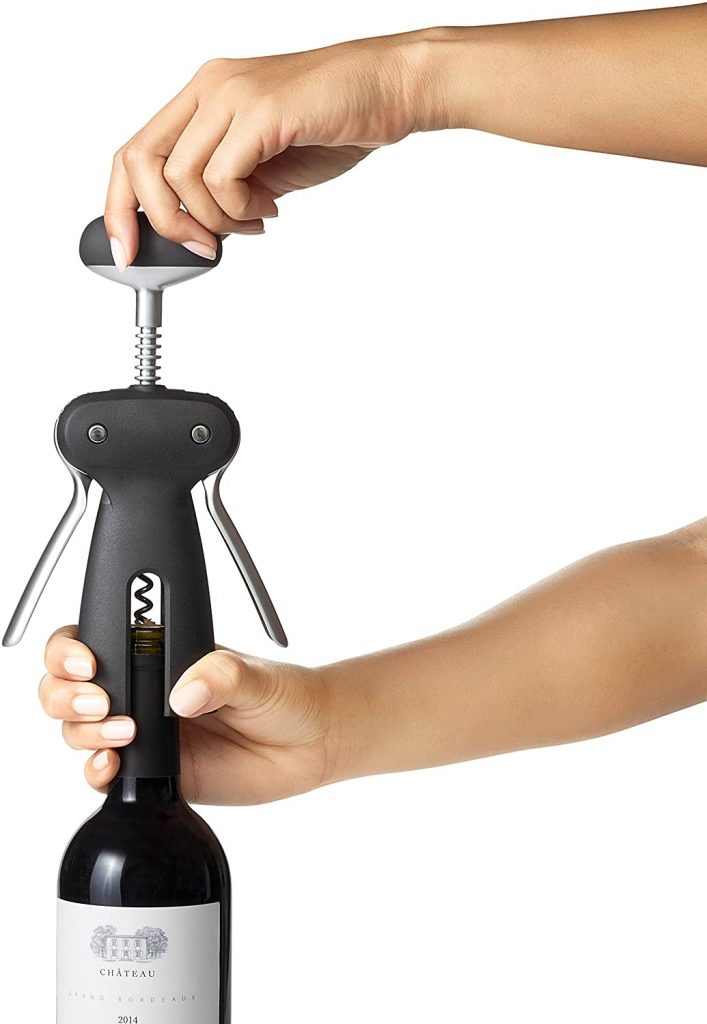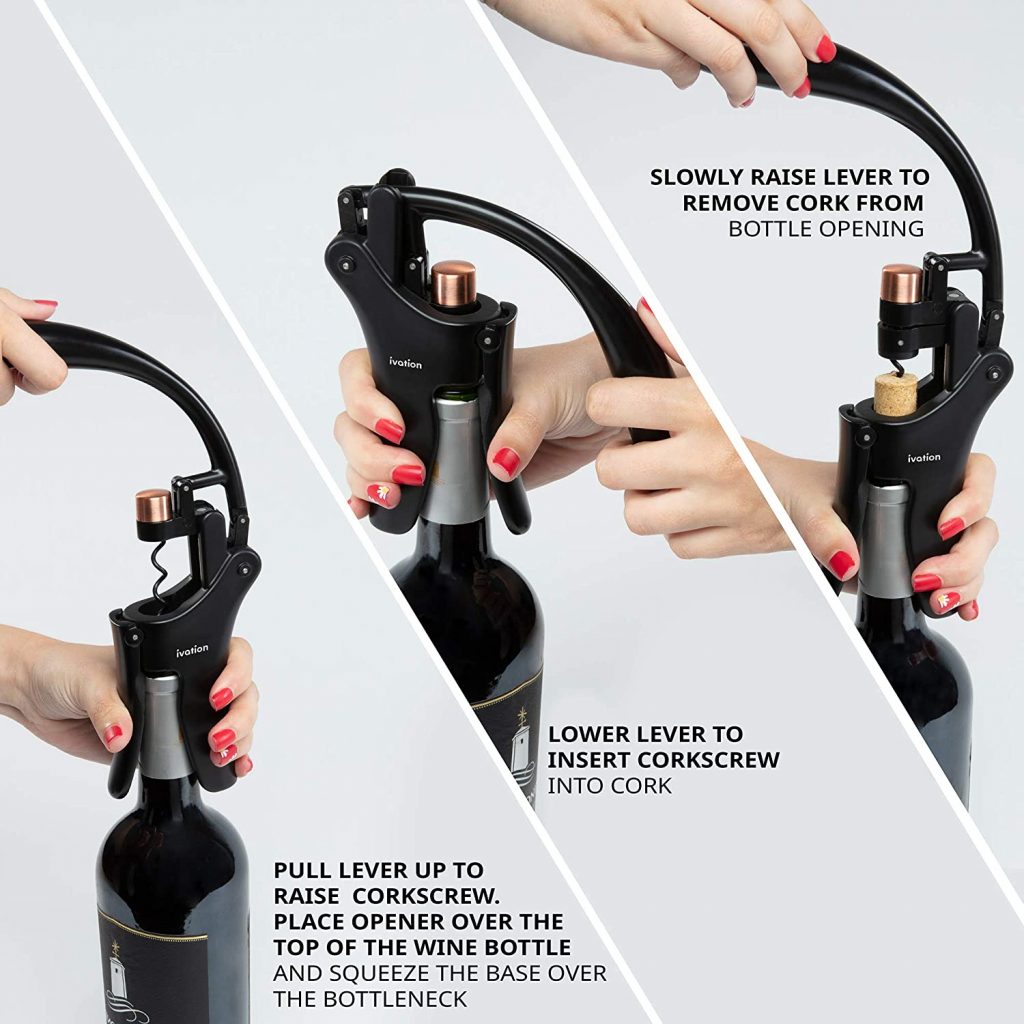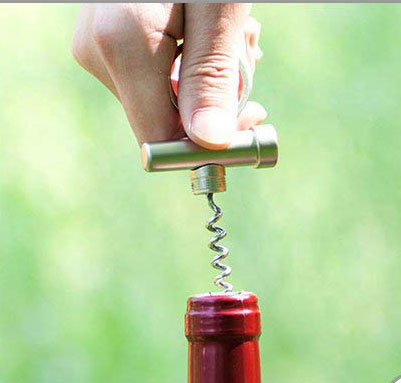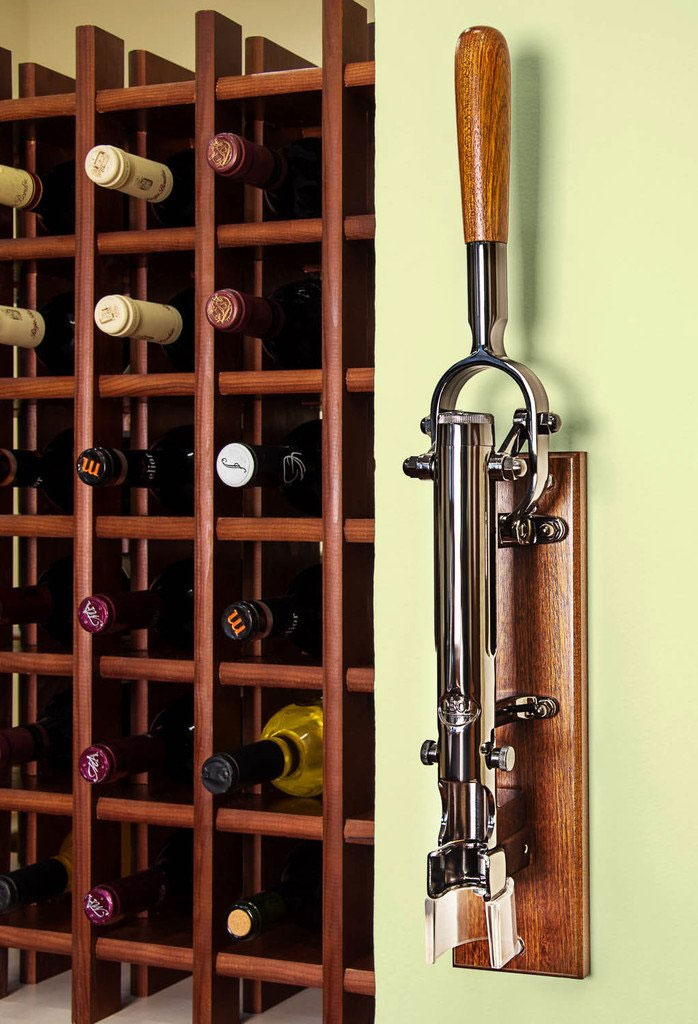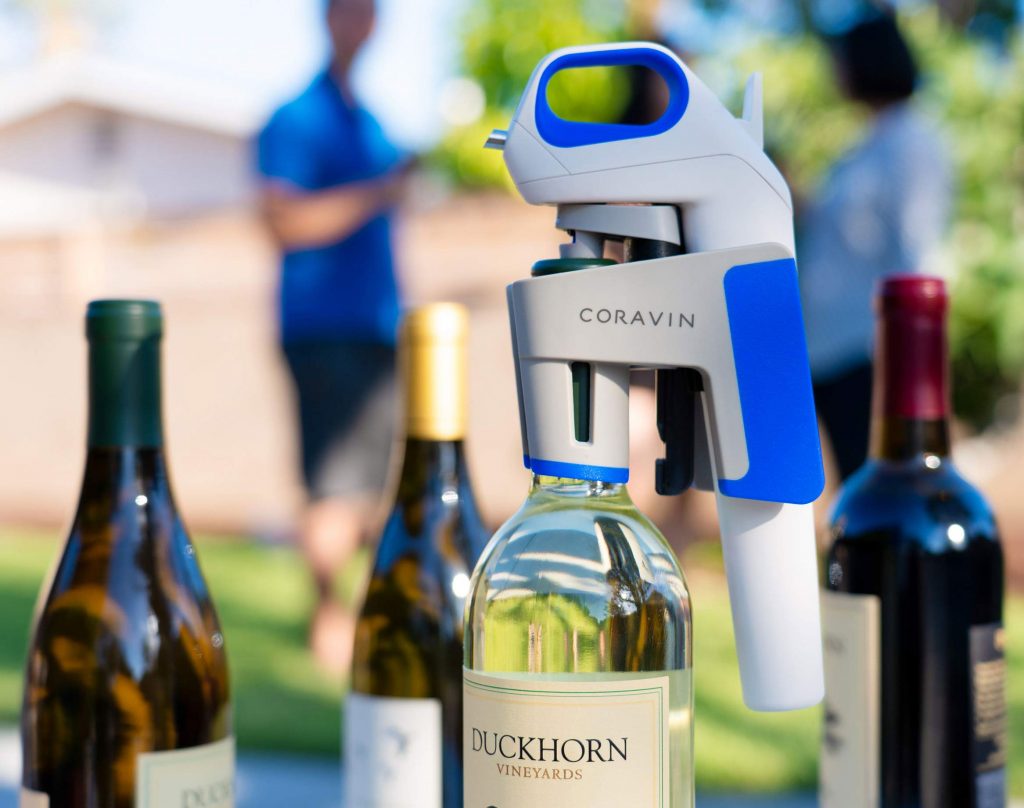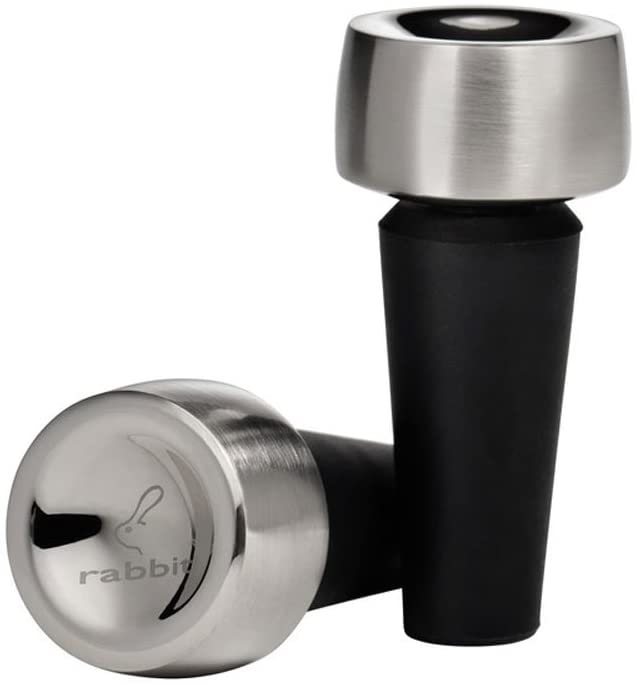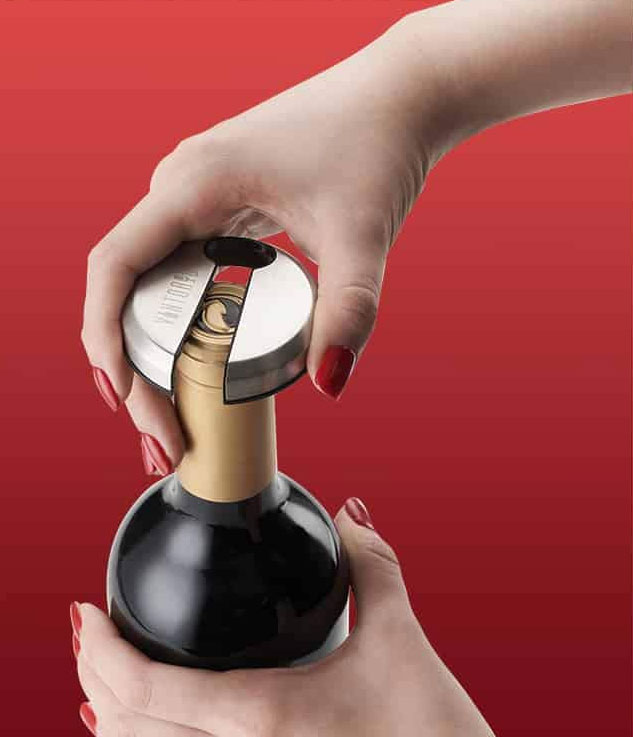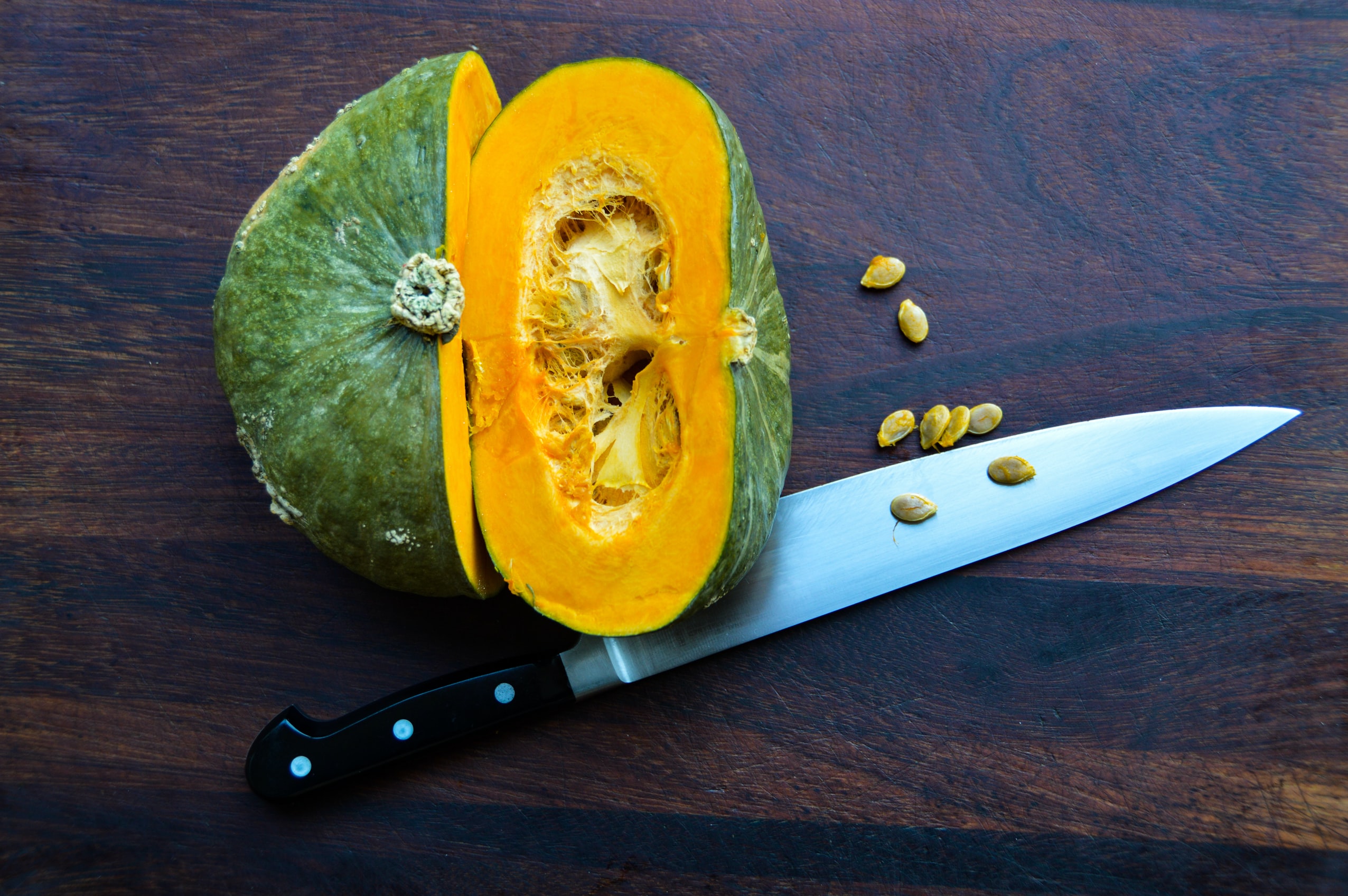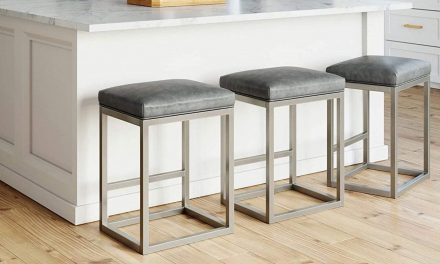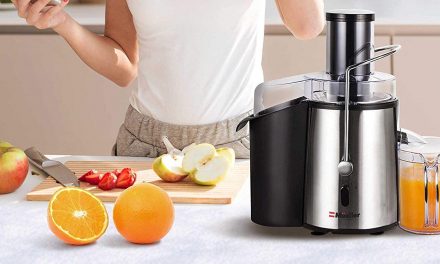Humans have been making and drinking wine for thousands of years, and we’ve been bottling it since the 17th century. But once you’ve got that bottle at home chilling (or not), what’s the best way to open it?
In this article, we’ll take a look at different types of wine bottle openers, as well as helpful accessories to improve your wine experience and the best ways of keeping leftover wine fresh.
Types of corkscrews or cork pullers
There are basically two kinds of wine bottle opener: a corkscrew and a cork puller.
Cork pullers look like two-pronged forks. Their narrow tines of metal are slipped into the bottleneck next to the cork. Pressure holds the tines to the cork while the cork is pulled out of the bottle.
A corkscrew, also sometimes called a worm or an auger, is a curled metal helix that works like a screw. All corkscrews essentially work by twisting the worm into the cork and then leveraging the cork out of the bottle.
Most wine bottle openers on the market are just different kinds of corkscrew, though we’ll take a look at both.
Automatic corkscrews
Automatic corkscrews are electric (battery powered or rechargeable) corkscrews that do almost all of the work for you. All you have to do is set the opening of the device over the cork, press the button, hold it steady, and the automatic corkscrew does the rest. Many models come with foil cutters, and some even come with temperature gauges so you can make sure your wine is at the optimal temperature.
Automatic corkscrews are fast and easy to use, but depending on the model, may not be especially portable. You can often buy them in sets that also come with wine bottle stoppers or an electric wine preservation system. They can be pricey, but they’re a great option for anyone who wants to spare their wrists and forearms the effort of manually removing a cork.
Ease of Use: Some models require you to hold the corkscrew steady over the cork, but overall they’re very easy to operate.
Good For: Frequent wine drinkers who don’t want to have to go through the trouble of manually removing corks.
Price Range: $15-$60 for bestselling electric bottle openers
Waiter’s corkscrews (a.k.a., the wine key)
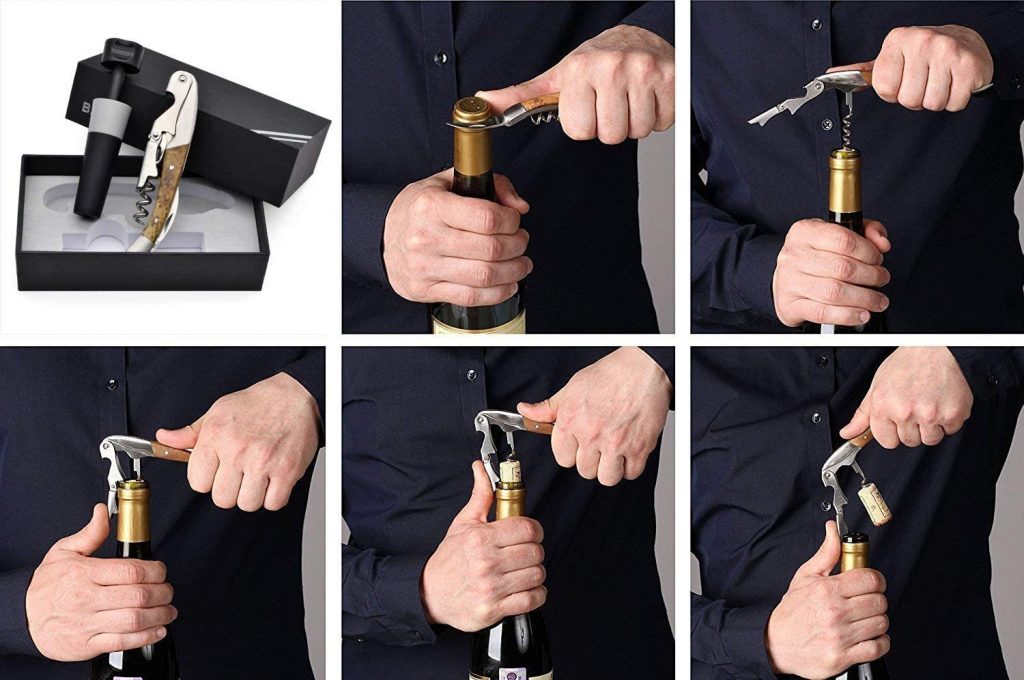
See Kit-Home’s wine key.
The waiter’s corkscrew gets its name from its popularity among waiters, who can easily fit the tool in a pocket until it’s needed. This portability is a great benefit of the style, and they’re generally lightweight too. Many also come with attached foil cutter knives, which is why this style is sometimes referred to as a “sommelier knife.”
To use a waiter’s corkscrew (or wine key, as it’s also called), you open up the hinge and pull the worm (corkscrew) out. Putting the point of the worm in the center of the cork and drilling it down until the edge of the shorter hinge can be brought flush against the rim of the bottle, you then brace the hinge against the rim and pull up the longer hinge, bringing the cork with it. If you’d like to see a video of someone using a waiter’s corkscrew, click here.
Waiter’s corkscrews range in size from inexpensive, practical models to pricier art pieces (Laguiole is a popular high-end brand). But if your main concern is ease-of-use, you may want to give these a miss. They’re much harder to use than most other styles and require some arm strength. When used improperly, they may leave bits of cork in your wine.
Ease of Use: Requires less arm strength than traditional manual corkscrews, but more technique and strength is necessary than with other styles.
Good For: Traditionalists looking for a small statement piece, the wine drinker on-the-go, and anyone less concerned about ease-of-use.
Price Range: $4-$50 for bestselling waiter’s corkscrews
Winged corkscrews
Winged corkscrews use the lever action of a wine key, but they have two levers, making the process much easier. Because of this design, winged corkscrews require less arm strength than waiter’s corkscrews as well. Some models may come with removable foil cutters, and you can also use the point of the worm to cut off the foil.
To use a winged corkscrew, you start with the wings down. Placing the point of the worm (corkscrew) in the center of the cork, you hold the body of the corkscrew straight and twist the key at the top as far as you can, which steadily lifts the wings. As you then manually pull down on the wings, the cork will come out. See here for a video.
Because of how they’re constructed, winged corkscrews are more likely to break than other styles, so they’re not great for heavy use. They’re also rougher on corks and shouldn’t be used on older bottles of wine, which may have more fragile corks. They tend to be larger than other manual styles, so they’re a bit less portable.
Ease of Use: Requires little arm strength and even less technique, though the twisting action may be hard on your wrist.
Good For: The casual wine drinker who isn’t especially concerned about portability.
Price Range: $5-$100 for bestselling winged corkscrews
Lever corkscrews
Much newer to the market than winged corkscrews or wine keys, lever corkscrews are designed with ease-of-use in mind. They require very little technique or arm strength and many come with removable foil cutters. Though, unlike automatic corkscrews, most lever corkscrews do still require two hands to use.
There are several styles of lever corkscrew. The most popular are called the houdini and the rabbit, though some other styles are also referred to as ‘rabbit’ corkscrews, so make sure you know exactly what you’re getting before you buy one. Generally, lever corkscrews consist of a Teflon-coated worm (corkscrew), some method of bracing the device (for the rabbit you squeeze the ‘ears’), and a lever that you pull up, then push down. To see someone using a lever corkscrew, check out this video.
Lever corkscrews are much more durable than winged corkscrews and can last for years with a little maintenance. The worm can dull, and the Teflon coating can wear down, but most models offer replacement worms. Because of how they’re designed, lever corkscrews can have problems with synthetic corks, but generally they are less likely than some other styles to leave bits of cork in the wine. They do tend to be fairly bulky, so portability might be an issue, and they’re definitely pricier than other styles.
Ease of Use: Requires almost no technique or arm strength, though both hands are needed.
Good For: Frequent wine drinkers who prioritize ease-of-use over portability.
Price Range: $20-$100 for lever corkscrews
Self-pull/screwpull corkscrews
Self-pull or screwpull corkscrews are another new entry into the wine opener market. They work most similarly to winged corkscrews, though, due to their fewer moving parts, tend to be much more durable. Compared to wine keys, they require far less arm strength and technique to use.
There are multiple styles of self-pull corkscrew, but they all work fairly similarly. To use, brace the body of the corkscrew against the bottleneck (for the rabbit style of self-pull corkscrew, this part would be the ‘ears’), twist the key on the top until the worm (corkscrew) is fully in the cork, then keep twisting until the cork is out. This style often comes with a built-in foil cutter.
Self-pull corkscrews tend to be more affordable than lever corkscrews while offering similar benefits. They also tend to be smaller and more portable than other easy-to-use corkscrews and make short work of wine corks. They’re a great compromise between ease-of-use, portability, and affordability.
Ease of Use: Requires very little arm strength or technique, though the twisting action may be hard on your wrist.
Good For: Anyone who wants the affordability of a reasonably priced wine key with the ease-of-use found in an electric or lever corkscrew.
Price Range: $15-$40 for screwpull wine openers on Amazon
Two-prong cork pullers (butler’s friend)
Eschewing the corkscrew entirely, a two-prong cork puller instead includes two metal tines of unequal length. Slipped into the bottleneck on either side of the cork, they are wiggled into the bottle until the base is flush against the cork. Then you simply twist and pull.
Two-prong cork pullers are fast and fairly simple to use, though they do require some technique and effort that may be hard on your wrist. They’re easy to clean and less likely than corkscrews to leave bits of cork in your wine. Most come with covers for easy portability, many come with separate foil cutters, and they’re super affordable.
Ease of Use: Doesn’t require a lot of force, but may be hard on your wrist.
Good For: Anyone who has difficulty with the twisting motion of corkscrews or who wants to ensure they never get bits of cork in their wine.
Price Range: $5-$25 for cork pullers on Amazon
Manual pull corkscrews
Manual pull, also called traditional or classic, corkscrews are the simplest and oldest form of corkscrew. Basically, manual pull corkscrews have two parts, the worm (corkscrew) and a crossbar handle. To use a manual corkscrew, you put the point of the worm in the center of the cork and drill it down until the worm has solid contact with the cork. Then, holding the bottle very tightly, you pull up on the handle until the cork comes free.
Manual pull corkscrews tend to be affordable and small. Some are even small enough to fit on keychains and to be part of multitools. They have no moving parts and are generally very durable. They do not typically come with foil cutters, though the point of the worm can sometimes be used to cut foil. The real downside of manual pull corkscrews is that they require the most technique and arm strength of any style. There are no levers to help out—it’s just you, the corkscrew, and the cork.
Ease of Use: It can be hard to twist the corkscrew in properly and requires a lot of arm strength to remove the cork. You may damage the cork in the process of a difficult removal.
Good For: Travelers who want a cheap, portable option or traditionalists who want a hands-on experience.
Price Range: $4-$50
Wall-mounted and tabletop corkscrews
At the other end of the spectrum are wall-mounted and tabletop corkscrews. These are more than just corkscrews—they’re a wine-opening experience. Whether wall-mounted or tabletop, these corkscrews, also sometimes called ‘legacy’ corkscrews, are generally very easy to use.
Styles vary, but most include a bottle mount that holds the bottle throughout the process. A large lever does the work of removing the cork. There’s no twisting or bracing necessary with this kind of corkscrew. These don’t generally come with foil cutters, but if you’re buying a showpiece like this, you’re probably also going to want a designated foil knife.
Wall-mounted and tabletop corkscrews are by far the most expensive style of wine bottle opener, and they are absolutely not portable. Think home bar or wine cellar, not purse or backpack. While tabletop corkscrews might be a bit more affordable than wall-mounted models, they’re all fairly pricey. There are also fewer options to choose from since this is definitely a niche style.
Ease of Use: Requires little technique or arm strength.
Good For: The true wine connoisseur who loves to entertain.
Price Range: $100-$450
Coravin preservation systems
People have been trying to preserve opened wine more effectively for centuries. Coravin brings this desire into the 21st century with their Pivot and Model lines.
The Pivot Wine Preservation System keeps wine fresh for up to a month with its specially designed stoppers. The stoppers, in combination with the device, replace the oxygen in an opened bottle with argon, thus preserving flavor, color, and aroma.
At a higher price point, the Model Bottle Opener and Preservation System takes this to a whole new level. Instead of replacing the cork with a stopper, with this system, you never remove the cork at all. A specially designed Teflon-coated needle pierces the cork while argon gas prevents oxygen from invading the bottle. You simply pour your wine, then remove the needle, and the cork seals itself. With this system, it’s like the bottle was never opened at all, and the remaining wine will stay preserved for years.
Ease of Use: The Model system can be slightly complicated to operate, but pouring is simple, and newer versions are much easier to use.
Good For: Wine lovers and connoisseurs who take their time with the bottle.
Price Range: $100-$400+ for Coravin preservation systems
Nice-to-haves: foil-cutting and preserving
For simpler and more affordable preservation, consider a wine bottle stopper. They don’t preserve as well as the Coravin systems mentioned above, but they will generally keep your wine fresh for at least a week. There are a variety of models to choose from, depending on your specific needs.
Another nice-to-have is a foil cutter, or foil knife. While many styles of corkscrew come with built-in or removable foil cutters, a separate tool might be preferable for wine enthusiasts. Most have a round or horseshoe-like design, though some are more arched and a few are more similar to the foil cutter on a wine key. You can also use foil cutters to chip away at hard wax on wax-sealed bottles.
Avoid wine bottle opening hacks
There are dozens of so-called wine bottle ‘hacks’ online. But do they work? And are they a good idea?
While there are dozens of different hacks popularized on youtube, tiktok, and elsewhere, most can be split up into a few basic types.
- Using a corkscrew like object
- Whether it’s a screw, a nail, a house key, a wire hanger, scissors, or a steak knife, there are tons of options for corkscrew alternative
- While some do work, many methods (especially the ones involving power tools) can be dangerous, and all of them are likely to leave bits of cork floating around in your wine
- If you have to employ one of these methods, stick to the screw and screwdriver method, as knives and scissors are much more likely to cut you. Under no circumstance should you ever swing a hammer at a wine bottle.
- Air pressure
- These methods attempt to increase the air pressure inside the wine bottle in order to pop the cork out
- Bike pumps and compressors more directly increase the air pressure while techniques involving heating the bottle (like lighters or a pot of boiling water) increase pressure indirectly
- All of these methods are dangerous. At best, you turn the cork into a projectile. At worst, you shatter the bottle. Do not attempt.
- Direct force
- Usually involves either wrapping the wine bottle in a towel (or in one viral tiktok, slipping a shoe over the bottom of the bottle) and hitting it against a wall or using something else to hit the base of the bottle
- The goal of this method is to slowly force the cork out of the bottle
- All of these methods are dangerous. At best, you spill wine on the floor. At worst, you shatter the bottle or injure your hand. Do not attempt.
- Breaking the top of the bottle off
- There’s only really two methods here: either literally breaking off the neck of the bottle, or sabering, a technique involving a sword and a bottle of champagne
- All of these are very bad ideas. The neck of the bottle will be sharp, and there might be bits of glass in your wine. Do not attempt.
- Pushing the cork into the wine
- This method consists of using something like a pen or a wooden spoon handle to force the cork into the bottle
- This method isn’t particularly dangerous, though you might leave bits of cork in your wine, and you may have trouble pouring it.
Basically, there are a few methods that might work, without being especially dangerous. But why try any of them when you can just get an actual wine bottle opener?
Wine bottle opener starter kit
No time for the deep dive? We’ll summarize.
- Looking for affordability and portability above all else? Buy a self-pulling corkscrew, such as OXO’s True Twister. At six inches, it’s not the smallest of solutions, but it’s way more likely to do a good and safe job than some other styles.
- Don’t care about portability, but need something easy on your arms and wrists? Go with an automatic wine bottle opener, like Secura’s highly-rated one that comes with a foil cutter. They’re not expensive, and they will save you a lot of trouble. Their only downside, really, is their size.
- Self-described wine snob with a house and money to burn? If you like to entertain, you can’t beat the elegance of a wall-mounted bottle opener. These work well and beautifully, if you’ve got the money and space for them.
- Wanting to preserve the wine you’ve opened? While wine stoppers will give you a couple of days to finish a bottle of wine, nothing can beat a fancy wine preservation system. If you’re willing to shell out the big bucks, Coravin’s Model Two is one of the best wine preservation systems on the market right now.

